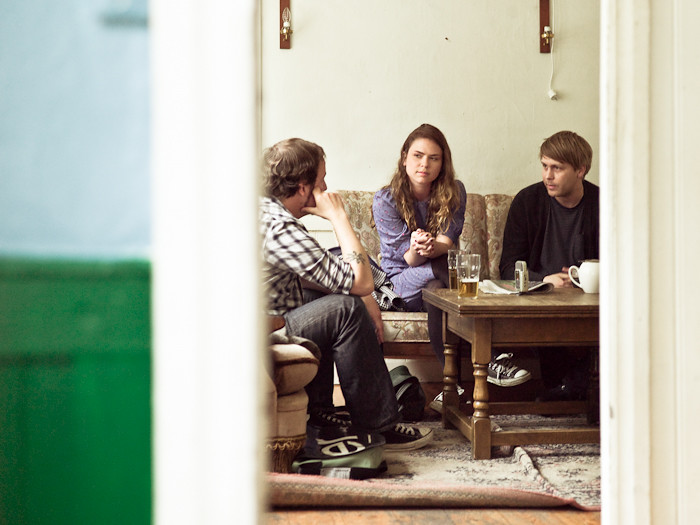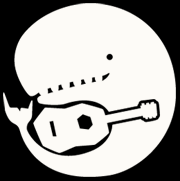A midsummer night’s dream? Talking about the Jónsvaka festival

Summer is a flimsy thing. Especially when you live in northern Europe. The days may be longer, but you get rain, cold fronts, sunburn because you forgot to bring sunblock for the 2 hours when the sun is actually shining, and in general you may not enjoy the season as much as the people living in Marseille, for example. Therefore it’s good if you have something to do inside, not depending on the weather. Even more so when the summer has reached its zenith, and the sun is out for one complete day. As it is on 21.06., or Midsummer. There are some interesting Midsummer-traditions around Scandinavia and Northern Europe, but it seems Iceland is a bit behind when it comes to that. Except the annual Midsummer-marathon, there’s not much going on around the day. Therefore a collective of people came up with the idea to have some kind of festivities in Iceland, and the Jónsvaka-festival was born. Sonic Iceland met with two of the organisers, Harpa and Daniel, at the Hemmi & Valdi cafe on Laugavegur, to learn more about the festival.
Sonic Iceland: Maybe you can talk a bit about the idea behind the festival, why you set it up, and about the program? If I understood correctly this is a festival for all areas of the arts, not only music?
Harpa: The festival is held on Midsummer, which is next Thursday. And the idea is that there’s basically nothing going on in Reykjavik on that date. Traditionally elsewehere in the northern countries, like Norway or Sweden, they have big festivals on this day, and even during the whole week. But here there’s been nothing going on, except a marathon or something. So the original idea was to make somthing happen this weekend. Something that everybody could participate in. Not very expensive, just for everyone to have fun – and that’s how it started. We began brainstorming in October/November, and been brainstorming since (laughs). We’ve been collecting funding for the festival, individual sponsors, setting up the team of course.
Daniel: It all started with this one person, Hildur, she had this idea, and there was this “Youth in Action”-programme for the EU, so she apllied for a grant there to do this. I was in the same music group, that’s how I knew her. Then she got the grant, and we started thinking “What should we do?”, and because we just knew something about music, and in the grant it was written to use it for “art”, all art, and especially for young people, so we got Harpa and Magret involved. Both had at the time started the company FRAFL, which focuses on young artists, producing and promoting visual art projects, so we – me, Hildur, and friend of ours called Leifur, Harpa and Magret, who conveniently is Leifurs wife, put everything together to make this festival. Harpa and Magret have been working on the arts-part, and we’ve been working on the music-part. Then again we got other companies like Faxafloi and Patron involved, and after that we got the Pop-Up-Store.
Harpa: There’s this company called Pop-Up Store, which creates pop-up fashion markets, for example here in the cafe, and also in galleries and other places. They are responsible for the design and fashion part of the festival. So we have parts of every arts-scene in Iceland represented, I’d say.
SI: That’s brilliant – especially when it all comes of the idea to have something going on on Midsummer’s day.
Daniel: I believe there reason why we don’t have anything happening on this day is because our Indepence Day is on the 17th of June, so there’s always a big festival and a free concert downtown, and maybe people didn’t think of having something big so close to that day.

SI: And how big is the festival? How many artists, art groups or collectives will be there altogether?
Harpa: Phew.
Daniel: The music part is 16 or 17 bands, divided over 3 days of shows, but we haven’t fully scheduled this. We are thinking about to have more concerts off-venues, where people don’t have to pay. We were also thinking about having a sound-system outside, so people could walk by and listen.
Harpa: We have 20 art projects, visual arts, dance, design, photo exhibitions, sound performances, video installations. Then we have 17 designers participating in the pop-up store, and then we have a fashion show also on Thursday, where 13 designers will show their fashion.
SI: Do you have a central venue for everything, or is it all over town?
Harpa: It’s all over. The concerts will be at NASA, and other main venues are the Reyjkavik Arts Museum, The Living Museum, the Crymo gallery, the Havari record store, and some events will also be happening downtown on the streets of Reykjavik.
SI: Will people be able to find this on the website? Or do you think Icelanders will anyway know where to go? And, as the festival is advertised as a platform for Icelandic arts, are you aiming at foreign visitors to come and see?
Daniel: We’ll have a brochure, and on Wednesday we are getting a hole page in Freytabladid, with the whole schedule there. We try to have everything there, but without shooting over the top – we do this for the first time. I can imagine if the festival goes well, that the city will sponsor us more, and give us some decent space.
Harpa: The info in the brochure will be both in Icelandic and in English, and the webpage also. Of course it will mainly be Icelanders coming, but welcome foreigners. Of course we do (laughs).
SI: Are all costs covered, by the grant you got? Or are you taking entrance fees?
Daniel: The concert is one thing where we take an entrance fee, and we also have an entrance fee for the fashion show.
Harpa: For participants of the fashion show – that’s normal for designers to pay some kind of participation fee, because it’s very expensive to set up a grand fashion show like this one will be, in the Reykjavik Arts Museum. And the concert is only 2999 ISK for three nights, which is very very cheap.
Daniel: Some of the bands we have would charge around 2000 ISK for playing a single show, so we are using the grant to lower the costs. And the city also gave us a grant, so “Youth in Action” are not the only ones sponsoring us.
Harpa: All other things, like the sound system etc. are covered, and there has been no problem at all.
Daniel: And also everyone who’s working for the festival is only taking a small amount,or nothing, so we’ve been working on this for nothing (laughs).
Harpa: For how many months? (laughs)
SI: When I compare this to art festivals in Germany, where everyone has to have a written contract and everything needs to be fixed and set in stone before people would start doing something, I think you are doing an amazing job. It’s very nice to see that something this big can function without having every detail done beforehand.
Harpa: I think it’s because this is the first time we are having this, so everybody is so optimistic and so willing to make this happen, so it has been very easy to co-operate with the galleries and the artists also. Okay, it has not been so easy with the artists (laughs).
Daniel: It’s because when working with Icelandic people it’s like “We’ll do this, we’ll fix this.”, and if it goes wrong, it just goes wrong. So maybe it’s that. But maybe something will go wrong.
SI: But then they can blame you.
Harpa: Let’s hope not.
SI: The booking of the bands, how do you handle this?
Daniel: We were open for any band to apply, sort of. Of course, this is a really small market, so Hildur knows a lot of bands through IMX, and we together at least knew one person from the bands, so I think we were able to get some of the best bands in Iceland at the moment. Or the best bands that we can afford (laughs).
SI: I really like that you have bands playing different sounds and styles, so people will get a good overview of who’s hot in Iceland at the moment.
Daniel: And we also tried to have similar music on the same nights, so Thursday will be the slowest, with low-key sounds. But we have a really nice mixture of bands for the festival. And it’s really cheap!
Harpa: For the arts scene we had open applications, opening in April, and we got something like 25 applications in total. And the idea was that if you fulfilled the very basic criteria we had for applying, you were in.
Daniel: Another thing about being cheap: when you have a look at the Icelandic music and arts scene after the crisis, everything bloomed really, you have concerts everywhere. And it’s getting harder and harder to get people into shows because there’s so much to choose from, so it’s better to have good bands and to have a low price to have the place full, so instead of getting some extra money out of it and have the bands play before a half-empty room. Every small town in Iceland is having a festival at the moment, and sometimes it seems everybody if fighting for the people to come to their thing and visit their town. But in all it’s very nice, I just hope it won’t be too overwhelming for people, there’s only 300.000 of us, I don’t know if we can bear this (laughs).
So, if you should happen to be in Reykjavik from the 24th of June on, there’s no better chance to get an overview of contemporary Icelandic art from all areas then the Jónsvaka festival. You can find all information (programme in English coming soon) on their website. Sonic Iceland will definitively be there.



